Operation Prairie Fire: The First Use of Harpoon Missiles In Combat by U.S. Navy A-6 Intruders
Operation Prairie Fire, launched in March 1986, was a response by the U.S. Navy to hostile actions from Libyan forces that had fired surface-to-air missiles (SAMs) at American aircraft that had crossed into Libya’s claimed “Line of Death” in the Mediterranean.
The operation marked a significant moment in naval warfare, as it involved the first combat use of the AGM-84 Harpoon missile by U.S. Navy A-6 Intruders.
These carrier-based aircraft were instrumental in attacking Libyan naval targets, including the fast attack craft Waheed. The A-6 Intruders, armed with Harpoon missiles and Rockeye cluster bombs, successfully engaged and severely damaged the Libyan vessel, showcasing the effectiveness of advanced anti-ship weaponry in modern naval combat.
The attack is described in detail in “Harpoon Missile vs Surface Ships” by author Lon Nordeen, who delivers a detailed account of the development, deployment, and combat use of the Harpoon anti-ship missile system.
Focusing on its use by the U.S. Navy, Nordeen explores how the missile shaped naval strategies during the 1980s. Originally developed to counter Soviet naval threats, the Harpoon was adopted by numerous countries, including Iran, which became one of the first to use it in combat.
Notably, the Iranian Navy deployed the missile during the Iran-Iraq War, and the same ship that first fired the missile in 1980 was later involved in a skirmish with the US Navy in 1988.
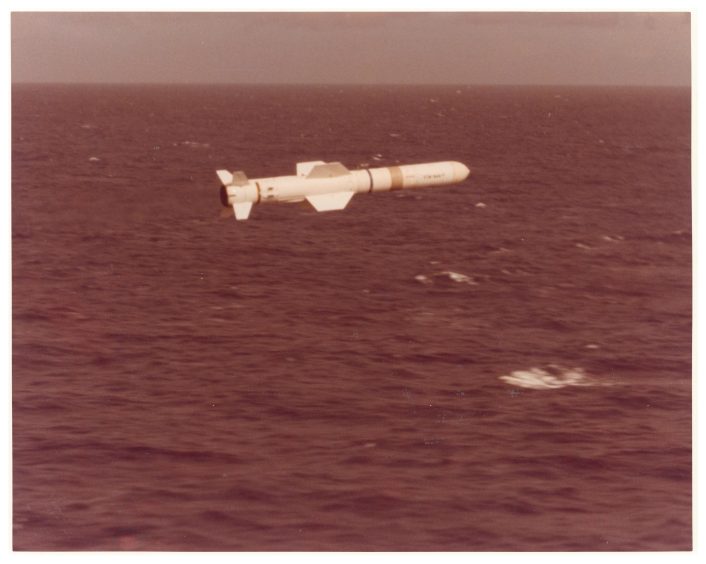
The book highlights how the Harpoon missile, along with other anti-ship weapons, revolutionized naval combat by increasing the range, lethality, and precision of strikes. Nordeen explains how these weapons forced navies to adapt, developing new detection, tracking, and defense systems to counter missile threats. The book underscores the difficulties of spotting incoming sea-skimming missiles and how navies worked to overcome these challenges with tactics and advanced sensor technologies.
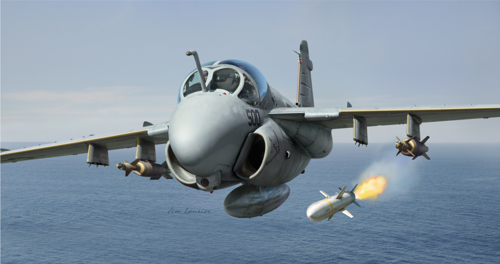
One of the most interesting parts of the book, is the one in which US Navy pilots and crew members recount their experiences during Operation Prairie Fire, which took place on Mar. 24, 1986 and marked the first use of the Harpoon. The operation was initiated after Libyan forces fired surface-to-air missiles (SAMs) at US Navy aircraft that had crossed Libya’s “Line of Death” in the Mediterranean. The text details the engagements between US aircraft, including F-14 Tomcats and A-6 Intruders, and Libyan naval and air forces. Notably, it describes how VA-34’s A-6 Intruders from USS America successfully attacked the Libyan fast attack craft Waheed using AGM-84 Harpoon missiles and Rockeye cluster bombs.
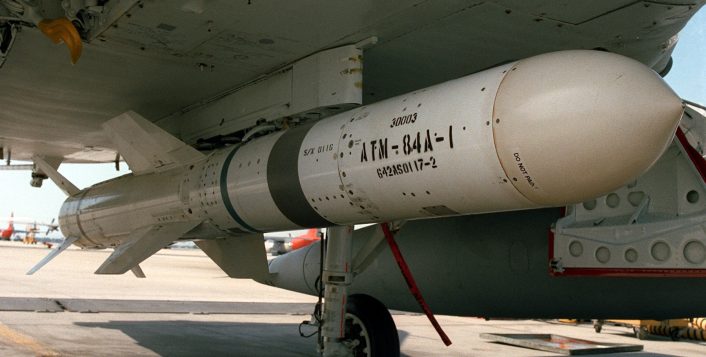
First combat use of the Harpoon
On March 24, 1986, the SAG comprising Ticonderoga, Scott and Caron (DD-970) crossed the “Line of Death” as part of Operation Attain Document III. F-14s covering the vessels were targeted by Libyan SA-2 and SA-5 SAMs over the next 24 hours, resulting in the instigation of Operation Prairie Fire by Sixth Fleet’s Task Force Zulu.
NFO Lt Dave Parsons was strapped into the back seat of one of the Tomcats that was targeted:
I was assigned to VF-102 “Diamondbacks”, flying F-14As off America. We had conducted a no notice deployment in February 1986 to join Saratoga and Coral Sea off Libya to challenge Gaddafi’s “Line of Death”. With three carriers on station, we knew there would likely be a confrontation. We were issued sidearms for first time in my career.
At 1352 hrs on March 24, we were underway on the wing of Lt Roy “Flash” Gordon, who flew with the skipper, Cdr Mike “Sparky” Lyle, as his RIO. Once on station [replacing a pair of VF-33 F-14s also from America that had intercepted two LAAF MiG-25s, which had then broken off the engagement just prior to the Tomcat crews being given permission to open fire], we flew a race-track pattern. “Flash” and “Sparky” were flying south, we north, when “Sparky’s” AWG-9 radar picked up a contact about 60 miles away. “Flash” turned in, thinking this would be another MiG-25 coming directly at him. “Sparky” locked onto the contact and “Flash” followed the target symbol in his head-up display, seeing the target accelerate through Mach 1, Mach 2 and Mach 3. He then spotted a vertical contrail. Moments later, we received a coded message via data link that the Libyans had fired an SA-5 at us. That’s when we realized the radar contact must be a SAM. We retired northwards vis a split-s maneuver while other assets confirmed our diagnosis.
Two SA-5s had in fact been fired by the battery at Sirte following a direct order by Gaddafi himself. The SAMs missed. Once it had been ascertained that the Libyans had indeed committed a hostile act, the US Navy now had the opportunity to strike back. Vice Admiral Kelso duly sent a flash precedence message to all warships in Task Force Zulu at 1538 hrs, informing them that contingency operation Prairie Fire had now commenced. This authorized warships and carrier-based aircraft to “engage Libyan units closing on the force in international waters and airspace”.
More clashes between LAAF MiG-25s and US Navy Tomcats and Hornets ensued, but these ended without any aircraft from either side being shot down. At 1830 hrs, two A-7Es armed with AGM-88s commenced an abortive attack on the Sirte SAM battery, but this was abandoned when they were targeted by two SA-5s and an SA-2.
Ninety minutes later, the Otomat ASM-armed fast attack craft Waheed of the Libyan Navy was detected by both an E-2C and Ticonderoga heading northwest at 24 knots from the naval base near Misratah directly towards the SAG. A SUCAP section of two A-6Es was immediately vectored towards Waheed by the Hawkeye, the Intruders from VA-34 being armed with AGM-84s and Mk 20 Rockeye II CBUs.
Flying the second A-6E was Lt Mike Dowty: My B/N, Lt Cdr Larry Schofield, and I made an evening launch [in “Blaster 507”] from America. We carried one AGM-84 Harpoon and two Rockeye cluster bombs. Lt Cdr Don Watkins launched before us, and our squadron CO, Cdr “Breeze” Coleman, flew an A-6 in tanker configuration. We were tasked with performing an ASUW [anti-surface warfare] patrol, during which we would check out any surface contacts assigned. If there were none previously identified, we would search assigned sectors, flying at around 3,000–5,000ft and 200 knots. Our radar would typically pick up contacts at around 30–50 miles, depending on a number of variables. We would report our contacts to “center” either directly or via a controlling E-2C. They would usually ask us to get a closer look with FLIR [forward-looking infrared], so we’d move to within a couple miles at lower altitude and higher speed. If the contact was of interest, we were asked to “bird-dog” [maintain contact].
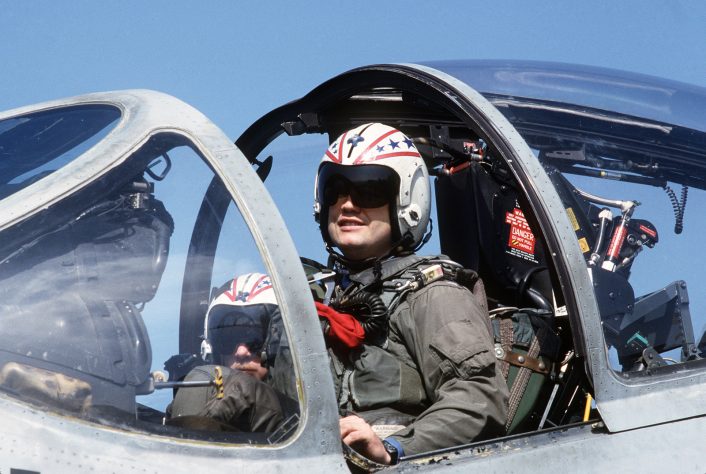
As noted by Dowty, Lt Cdr Watkins and B/N Lt Rick Serex were flying just ahead of him and Schofield.
According to Watkins:
About half-an-hour into the flight [in “Blaster 505”], I was vectored towards a surface contact by our early warning, command and control E-2C aircraft and tasked with identifying it. Using our FLIR, we were able to identify the surface vessel as a La Combattante fast attack class patrol boat [Waheed], and reported its position, heading and speed back to the E-2C.
Our instructions were to “bird-dog” with the ship – something we had a lot of practice doing during years of Cold War operations against the Soviets. After approximately 20 minutes (at around 2015 hrs local time), we received coded orders to attack the ship. As we verified the order to attack was legitimate, I was slightly to the southwest of the vessel, and we could see commercial shipping just to the north of the patrol craft. While the early versions of the Harpoon could limit the size of its search area to some degree, we weren’t altogether comfortable that its radar wouldn’t lock onto a larger commercial vessel in the vicinity, vice the smaller patrol craft. Because of this constraint to the weapon, our CO [Cdr Richard G. Coleman] told us that if we did happen to engage any surface ships, we could only shoot Harpoons from north to south. Therefore, I began to maneuver around to the north, which would enable us to fire with a clear shot to the south.
Although “Blaster 505” had been the first to identify the contact, it was actually “Blaster 507” that was better positioned to attack.
Dowty recalled:
We checked in with the E-2Cs and they told us “we have a couple of contacts – we want you to go ‘bird-dog’ one coming out of Tripoli”. The controllers then said, “‘Blaster 505’, go check this one out (it was the closer one) and ‘Blaster 507’, go east”. We headed east and joined up with two A-7s, and when we got a bit more than halfway to our target, Don Watkins came up and identified the boat by type – we had a code word that night for a La Combattante-class patrol boat and another for the larger Nanuchka-class corvette. He identified it, and we then heard “alpha sierra passes stable”. According to the code words written on my knee board, this said “ATTACK!”
I now knew I had to turn around and speed west, so I asked the E-2C controller, “Anything out there?”, to which he answered, “Negative”. So, I told Larry, “Get on that radar and check”. He did not see anything but one blip. We were at about 3,000ft, headed west-southwest, and it was dark, but there was moonlight. We shot the Harpoon at a range of about 22 miles. I looked out and saw the missile fall away from the jet. I watched it drop into the darkness and then the motor fired up and it sped out in front of us, but it did not seem to be traveling all that much faster than we were.
We were turning away from the target when the Harpoon hit. Don Watkins and others saw the impact, but we did not.
Watkins did indeed see “Blaster 507’s” missile strike its target.
As we circled back to the north, “Blaster 507” attacked from a more northeast to southwest approach, and were able to execute the first clear shot. Their Harpoon clearly struck the La Combattante’s superstructure, before exploding a fraction of a second later, and they continued their attack, dropping their Rockeye.
Dowty described the follow-up attack with Mk 20 Rockeye CBUs as follows:
The only other radio comms I heard was from Don Watkins. He was loitering around the target, but he was not getting a good BIT [built-in test] check from his Harpoon. So, after our Harpoon hit, we set up for a follow up-attack with Rockeye cluster bombs. However, we screwed up the first pass due to FLIR and computer issues, so we had to circle around for another go, from a north-to-south angle.
The FLIR was stuck, so I said we would circle around to put the target in the moonlight. I told Larry, “We are going to step up the altitude to 500ft so we can get a good radar lock, and you will have time to sweeten the angles for a successful bombing attack”. Larry replied, “Skipper said never go back and reattack the same target again!” I said, “They are not shooting at us, so we are going back!” So, we bombed the ship with Rockeye. As we pulled away, Don Watkins called “Bulldog away”, which meant he was firing his Harpoon at the target.
Watkins recalled “Blaster 505’s” AGM-84 attack:
As “Blaster 507” cleared the target, we were then in position to fire. Our Harpoon struck the Libyan craft, which was left totally dead in the water. As we continued towards the vessel, we could see that only the bow of the ship remained afloat, with the bulk of it engulfed in heavy flames. Seeing the ship on the verge of sinking, and believing there may be other threats to the fleet, we decided to retain our Rockeye in case they might be needed against any other Libyan naval vessels in the area. When our fuel began to run low we returned to the ship.
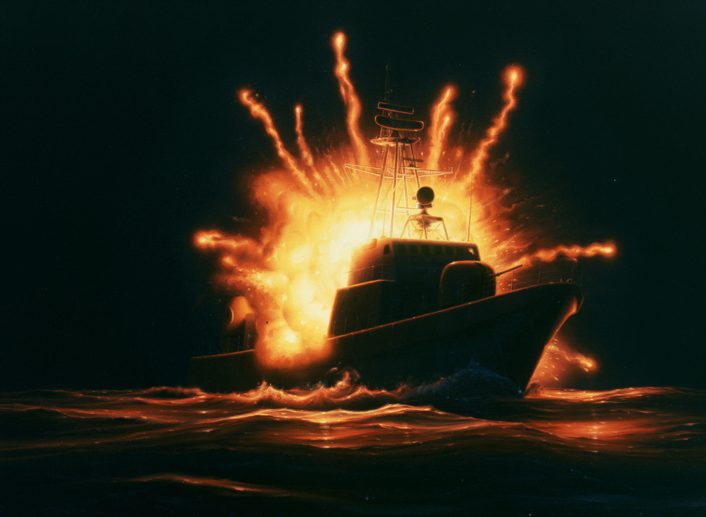
The next morning the Spanish tanker SS Castillo de Ricote rescued 16 Libyan survivors from Waheed. According to VA-34’s mission write-up, “Intruder crews learned from the attack that it is fairly easy to severely damage and stop a ship, especially one with exposed missiles topside. However, the ship’s structural compartmentalization can make it much more difficult to sink”.

